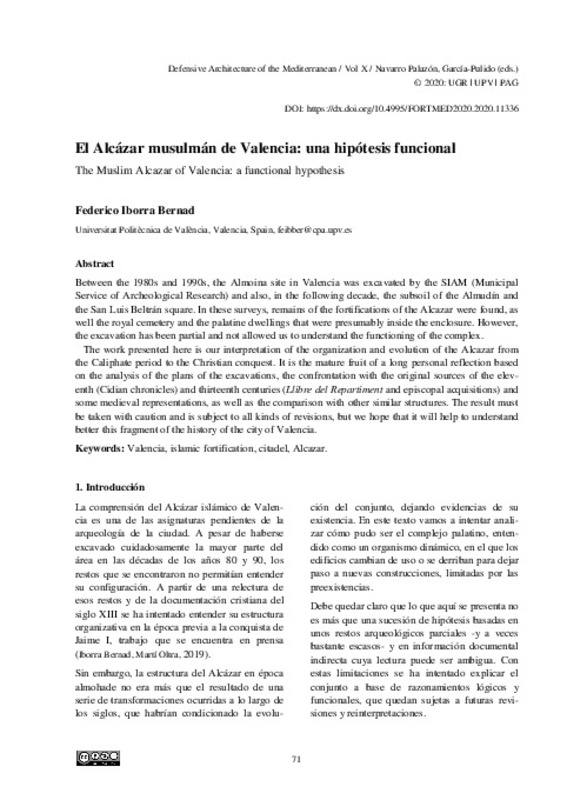JavaScript is disabled for your browser. Some features of this site may not work without it.
Buscar en RiuNet
Listar
Mi cuenta
Estadísticas
Ayuda RiuNet
Admin. UPV
El Alcázar musulmán de Valencia: una hipótesis funcional
Mostrar el registro sencillo del ítem
Ficheros en el ítem
| dc.contributor.author | Iborra Bernad, Federico Javier
|
es_ES |
| dc.coverage.spatial | east=-0.3744524999999999; north=39.475746; name=Plaça de l'Almoina, 3, 46001 València, Valencia, Espanya | es_ES |
| dc.date.accessioned | 2020-06-26T10:14:45Z | |
| dc.date.available | 2020-06-26T10:14:45Z | |
| dc.date.issued | 2020-05-15 | |
| dc.identifier.isbn | 9788490488560 | |
| dc.identifier.uri | http://hdl.handle.net/10251/147067 | |
| dc.description.abstract | [EN] Between the 1980s and 1990s, the Almoina site in Valencia was excavated by the SIAM (Municipal Service of Archeological Research) and also, in the following decade, the subsoil of the Almudín and the San Luis Beltrán square. In these surveys, remains of the fortifications of the Alcazar were found, as well the royal cemetery and the palatine dwellings that were presumably inside the enclosure. However, the excavation has been partial and not allowed us to understand the functioning of the complex. The work presented here is our interpretation of the organization and evolution of the Alcazar from the Caliphate period to the Christian conquest. It is the mature fruit of a long personal reflection based on the analysis of the plans of the excavations, the confrontation with the original sources of the eleventh (Cidian chronicles) and thirteenth centuries (Llibre del Repartiment and episcopal acquisitions) and some medieval representations, as well as the comparison with other similar structures. The result must be taken with caution and is subject to all kinds of revisions, but we hope that it will help to understand better this fragment of the history of the city of Valencia. | es_ES |
| dc.language | Español | es_ES |
| dc.publisher | Editorial Universitat Politècnica de València | es_ES |
| dc.rights | Reconocimiento - No comercial - Sin obra derivada (by-nc-nd) | es_ES |
| dc.subject | Fortifications | es_ES |
| dc.subject | Mediterranean | es_ES |
| dc.subject | Modern age | es_ES |
| dc.subject | Built Heritage | es_ES |
| dc.subject | Valencia | es_ES |
| dc.subject | Islamic fortification | es_ES |
| dc.subject | Citadel | es_ES |
| dc.subject | Alcazar | es_ES |
| dc.title | El Alcázar musulmán de Valencia: una hipótesis funcional | es_ES |
| dc.title.alternative | The Muslim Alcazar of Valencia: a functional hypothesis | es_ES |
| dc.type | Capítulo de libro | es_ES |
| dc.type | Comunicación en congreso | es_ES |
| dc.identifier.doi | 10.4995/FORTMED2020.2020.11336 | |
| dc.rights.accessRights | Abierto | es_ES |
| dc.contributor.affiliation | Universitat Politècnica de València. Departamento de Composición Arquitectónica - Departament de Composició Arquitectònica | es_ES |
| dc.contributor.affiliation | Universitat Politècnica de València. Escuela Técnica Superior de Arquitectura - Escola Tècnica Superior d'Arquitectura | es_ES |
| dc.description.bibliographicCitation | Iborra Bernad, FJ. (2020). El Alcázar musulmán de Valencia: una hipótesis funcional. Editorial Universitat Politècnica de València. 71-78. https://doi.org/10.4995/FORTMED2020.2020.11336 | es_ES |
| dc.description.accrualMethod | OCS | es_ES |
| dc.relation.conferencename | FORTMED2020 - Defensive Architecture of the Mediterranean | es_ES |
| dc.relation.conferencedate | Octubre 01-03,2020 | es_ES |
| dc.relation.conferenceplace | Granada, Spain | es_ES |
| dc.relation.publisherversion | http://ocs.editorial.upv.es/index.php/FORTMED/FORTMED2020/paper/view/11336 | es_ES |
| dc.description.upvformatpinicio | 71 | es_ES |
| dc.description.upvformatpfin | 78 | es_ES |
| dc.type.version | info:eu-repo/semantics/publishedVersion | es_ES |
| dc.relation.pasarela | OCS\11336 | es_ES |








